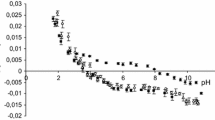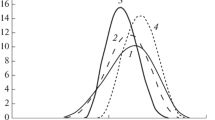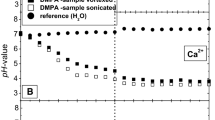Summary
Liposomes prepared from 6.3∶1.8∶0.9∶ 1.0 molar mixtures of phosphatidylcholine, dicetyl phosphate, cholesterol, and phosphatidylserine, respectively, (PS(+) liposomes) were compared with similarly prepared liposomes without the phosphatidylserine (PS(−) liposomes) for their effect on calcium phosphate precipitate formation in aqueous solutions at pH 7.4 and 22°C. The liposomes, encapsulated with 50 mM phosphate (PI), were suspended in buffered 2.2 mM CaCl2, 0 or 1.5 mM KH2PO4 solutions and made permeable to Ca2+ fluxes with the ionophore, X-537A. External solution Ca2+ losses were found to be small in both PS(+) and PS(−) liposome suspensions when no ionophore was added. Even with 1.5 mM PI in the external solution, these losses did not exceed 0.2 mM. However, inoculating both liposome preparations with X-537A resulted in rapid, appreciable losses in solution Ca2+. Previous studies showed that in PS(−) liposomes, these latter losses were due to calcium phosphate precipitation, with the precipitate confined to the interior of the liposomes when no external PI was present, but extending to outside the liposomes when the suspending medium was rendered metastable. In the present study, Ca2+ losses resulting from intraliposomally confined precipitation were found to be marginally greater in PS(+) liposomes due primarily to a larger volume of entrapped PI available for reaction in these liposomes. However, with the addition of PI to the external solution, the reverse was observed, i.e., considerably less Ca2+ was lost in PS(+) than in PS(−) suspensions, a result of markedly less X-537A-induced precipitate forming outside PS(+) liposomes. The most probable explanation for this latter decrease was a PS-induced adherence of the outer liposome membranes to the surfaces of developing crystals, restricting the avialability of these surfaces as sites for further growth.
Similar content being viewed by others
References
Eanes ED, Hailer AW, Costa JL (1984) Calcium phosphate formation in aqueous suspensions of multilamellar liposomes. Calcif Tissue Int 36:421–430
Eanes ED, Hailer AW (1985) Liposome-mediated calcium phosphate formation in metastable solutions. Calcif Tissue Int 37:390–394
Anderson HC (1980) Calcification processes. Pathol Annu 15:45–75
Boskey AL (1981) Current concepts of the physiology and biochemistry of calcification. Clin Orthop Rel Res 157:225–257
Wuthier RE (1982) The role of phospholipid-calcium-phosphate complexes in biological mineralization. In: Anghileri LJ, Tuffet-Anghileri AM (eds) The role of calcium in biological systems, CRC Press, Boca Raton, p 41
Wuthier RE (1968) Lipids of mineralizing epiphyseal tissues in the bovine fetus. J Lipid Res 9:68–78.
Wuthier RE (1982) A review of the primary mechanism of endochondral calcification with special emphasis on the role of cells, mitochondria and matrix vesicles. Clin Orthop Rel Res 169:219–242
Boskey AL, Posner AS (1977) The role of synthetic and bone extracted Ca-phospholipid-PO4 complexes in hydroxyapatite formation. Calcif Tissue Res 23:251–258
Schieren H, Rudolph S, Finkelstein M, Coleman P, Weissmann G (1978) Comparison of large unilamellar vesicles prepared by a petroleum ether vaporization method with multilamellar vesicles. Biochim Biophys Acta 542:137–153
Rouser G, Siakotos AN, Fleischer S (1966) Quantitative analysis of phospholipids by thin-layer chromatography and phosphorus analysis of spots. Lipids 1:85–86
Murphy J, Riley JP (1962) A modified single solution method for the determination of phosphate in natural waters. Anal Chim Acta 27:31–36
Eanes ED (1980) Crystal growth of mineral phases in skeletal tissues. Prog Crystal Growth Charact 3:3–15
Hendrickson HS, Fullington JG (1965) Stabilities of metal complexes of phospholipids: Ca(II), Mg(II), and Ni(II) complexes of phosphatidylserine and triphosphoinositide. Biochemistry 4:1599–1605
Wilschut J, Duzgunes N, Hoekstra D, Papahadjopoulos D (1985) Modulation of membrane fusion by membrane fluidity: temperature dependence of divalent cation-induced fusion of phosphatidylserine vesicles. Biochemistry 24:8–14
Papahadjopoulos D, Vail WJ, Jacobson K, Poste G (1975) Cochleate lipid cylinders: formation by fusion of unilamellar lipid vesicles. Biochim Biophys Acta 394:483–491.
Serhan C, Anderson P, Goodman E, Dunham P, Weissmann G (1981) Phosphatidate and oxidized fatty acids are calcium ionophores. J Biol Chem 256:2736–2741
Fraley R, Wilschut J, Duzgunes N, Smith C, Papahadjopoulos D (1980) Studies on the mechanism of membrane fusion: role of phosphate in promoting calcium ion-induced fusion of phospholipid vesicles. Biochemistry 19:6021–6029
Wuthier RE, Eanes ED (1975) Effect of phospholipids on the transformation of amorphous calcium phosphate to hydroxyapatite in vitro. Calcif Tissue Res 19:197–210
Anderson HC (1969) Vesicles associated with calcification in the matrix of epiphyseal cartilage. J Cell Biol 41:59–72
Bonucci E (1970) Fine structure and histochemistry of calcifying globules in epiphyseal cartilage. Z Zelleforsch Mikrosk Anat 103:192–217
Anderson HC, Cecil R, Sajdera SW (1975) Calcification of rachitic rat cartilage in vitro by extracellular matrix vesicles. Am J Pathol 79:237–254
Majeska RJ, Holwerda DL, Wuthier RE (1979) Localization of phosphatidylserine in isolated chick epiphyseal cartilage matrix vesicles with trinitrobenzene-sulfonate. Calcif Tissue Int 27:41–46
Boyan-Salyers BD, Vogel JJ, Riggan LJ, Summers F, Howell RE (1978) Application of a microbial model to biologic calcification. Metab Bone Dis Rel Res 1:143–148
Ennever J, Vogel JJ, Rider LJ, Boyan-Salyers BD (1976) Nucleation of microbiologic calcification by proteolipids. Proc Soc Exp Biol Med 152:147–150
Peress NS, Anderson HC, Sajdera SW (1974) The lipids of matrix vesicles from bovine fetal cartilage. Calcif Tissue Res 14:275–281
Wuthier RE (1975) Lipid composition of isolated epiphyseal cartilage cells, membranes and matrix vesicles. Biochem Biophys Acta 409:128–143
Anderson HC (1976) Osteogenetic epithelial-mesenchymal cell interactions. Clin Orthop Rel Res 119:221–224
Bonucci E (1981) Intra- vs. extra-vesicle calcification in epiphyseal cartilage. In: Ascenzi A, Bonucci E, de Bernard B (eds) Matrix vesicles. Wichtig Editore, Milano, p 167
Bernard GW (1969) The ultrastructural interface of bone crystals and organic matrix in women and lamellar endochondral bone. J Dent Res 48:781–788
Jones JS, Boyde A (1983) Ultrastructure of dentin and dentinogenesis. In: Linde A (ed) Dentin and dentinogenesis, vol. I. CRC Press, Boca Raton, p 81
Author information
Authors and Affiliations
Rights and permissions
About this article
Cite this article
Eanes, E.D., Hailer, A.W. Calcium phosphate precipitation in aqueous suspensions of phosphatidylserine-containing anionic liposomes. Calcif Tissue Int 40, 43–48 (1987). https://doi.org/10.1007/BF02555727
Received:
Revised:
Issue Date:
DOI: https://doi.org/10.1007/BF02555727




